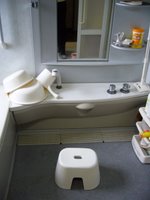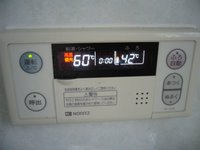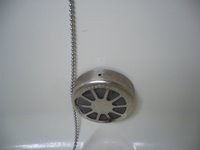 I adore taking baths and that is certainly one of the attractions of living in Japan. Adult Australians don't use the bath so much - maybe once a week or less. Most people I know just shower every day. Maybe this is a lifestyle choice or maybe it is because water is a precious commodity in Australia. (Though to be honest, taking a long shower probably uses just as much water as having a bath!) Japanese find it disgusting, but Aussies (and other westerners) add soap or bubble bath into the water and don't rinse off afterwards. I was certainly a weird Australian because I liked to have a shower first then use the tub to relax. Mind you, this was not good for either the electricity (hot water) bill or the water bill!
I adore taking baths and that is certainly one of the attractions of living in Japan. Adult Australians don't use the bath so much - maybe once a week or less. Most people I know just shower every day. Maybe this is a lifestyle choice or maybe it is because water is a precious commodity in Australia. (Though to be honest, taking a long shower probably uses just as much water as having a bath!) Japanese find it disgusting, but Aussies (and other westerners) add soap or bubble bath into the water and don't rinse off afterwards. I was certainly a weird Australian because I liked to have a shower first then use the tub to relax. Mind you, this was not good for either the electricity (hot water) bill or the water bill!Imagine my joy when I came to Japan and was told by my homestay sister that I had to take a shower first, then after I was clean I could get in the bath. Yay! I was surprised though, because the style of the bathroom was very different...
 Take a look at these pictures. This is my parents-in-law's bathroom. Mine is very much the same but has tiled walls instead of molded walls. Tiles look nice but are hard to clean. I suppose the new molded unit style bathrooms are popular because there are no cracks for mold to grow in. (NOTE: 1. mold = shape e.g. jelly mold / 2. mold = fungus e.g. the green stuff that grows in your bathroom if you don't clean it!)
Take a look at these pictures. This is my parents-in-law's bathroom. Mine is very much the same but has tiled walls instead of molded walls. Tiles look nice but are hard to clean. I suppose the new molded unit style bathrooms are popular because there are no cracks for mold to grow in. (NOTE: 1. mold = shape e.g. jelly mold / 2. mold = fungus e.g. the green stuff that grows in your bathroom if you don't clean it!)Anyway, the first difference is a Japanese bathroom is in two parts. The outer room is where the wash-stand is and where you change clothes. The washing machine is usually here, too. Then you go through a second door (glass or thick perspex) and into the wet area - perhaps about 2m x 2m in area. The bath is to one side and the remaining area is where you SIT and take a shower.
 I don't know the real reason why this is so but my guess is that sitting came from the custom of dipping water out of a large bath to wash yourself. In the old days there were no showers so you had to use a dipper. I don't have one in my bathroom but you can see one in the photos. There is also a plastic seat and basins. If you have a very gorgeous bathroom they are made from wood but I think wood would get moldy.
I don't know the real reason why this is so but my guess is that sitting came from the custom of dipping water out of a large bath to wash yourself. In the old days there were no showers so you had to use a dipper. I don't have one in my bathroom but you can see one in the photos. There is also a plastic seat and basins. If you have a very gorgeous bathroom they are made from wood but I think wood would get moldy.You actually can stand up to take a shower in modern bathrooms because the shower head is on the end of a hose and it can be fitted into various brackets on the wall at different heights. The new molded type bathrooms have a ledge in front and the hose retracts inside so you can't see it.
 But the best part of a Japanese bathroom (or many of them) is that the bathtub is really like a hot-tub. They have automatic temperature settings and will keep the bath water at a constant heat. Imagine being able to take a bath for hours and the water never getting cold!
But the best part of a Japanese bathroom (or many of them) is that the bathtub is really like a hot-tub. They have automatic temperature settings and will keep the bath water at a constant heat. Imagine being able to take a bath for hours and the water never getting cold!My sister was surprised once when my bath began to 'talk'. Actually, it wasn't the bath but the control panel on the wall of my kitchen. There are
 two panels, one in the bathroom and yes, one in the kitchen. This means you can control the bath from the kitchen - very handy for mothers! After you clean the bath from the day before, just put in the plug again and leave it. The next evening you only have to press one button and the bath will automatically fill up to the correct level and temperature. How? Well there is a inlet/outlet in the side of the bath that pumps hot water in and circulates the water through the heater again when the bath cools. I guess the bath takes about 10 minutes to fill and the panel suddenly says "The bath is almost ready." A few minutes later it plays a chime and says "The bath is now ready."
two panels, one in the bathroom and yes, one in the kitchen. This means you can control the bath from the kitchen - very handy for mothers! After you clean the bath from the day before, just put in the plug again and leave it. The next evening you only have to press one button and the bath will automatically fill up to the correct level and temperature. How? Well there is a inlet/outlet in the side of the bath that pumps hot water in and circulates the water through the heater again when the bath cools. I guess the bath takes about 10 minutes to fill and the panel suddenly says "The bath is almost ready." A few minutes later it plays a chime and says "The bath is now ready."Ah, the wonders of modern technology. If I ever had to go back to Australia, I am sure I would be taking a Japanese bathroom with me!
No comments:
Post a Comment